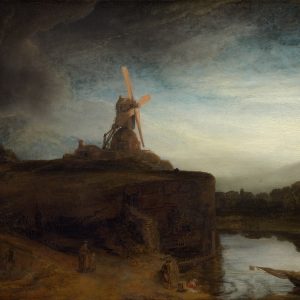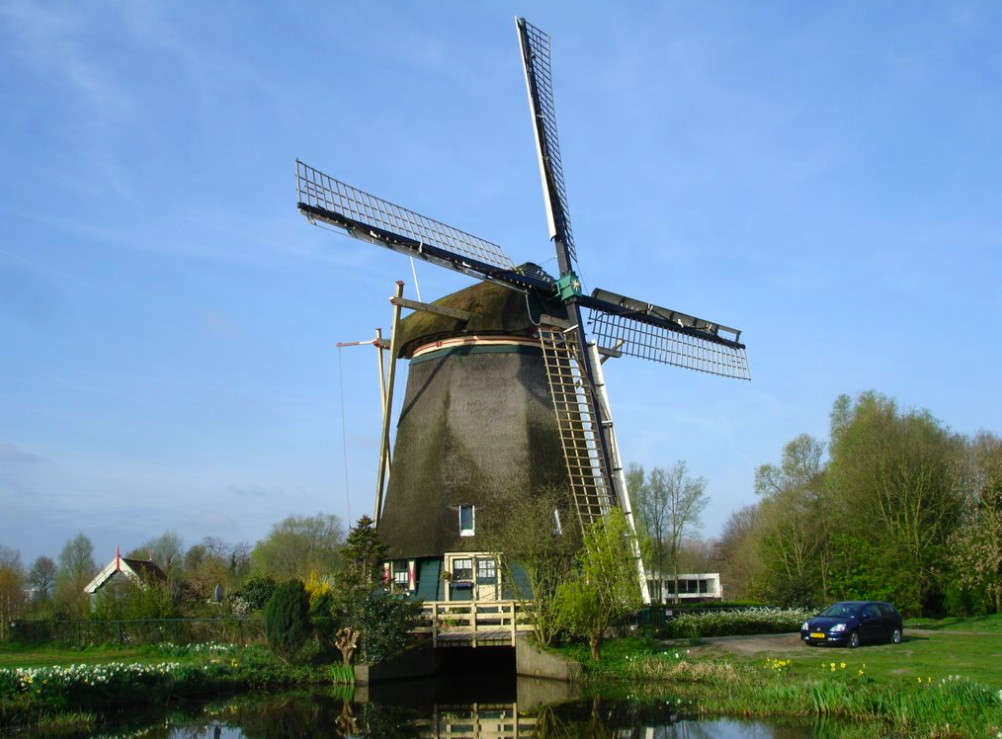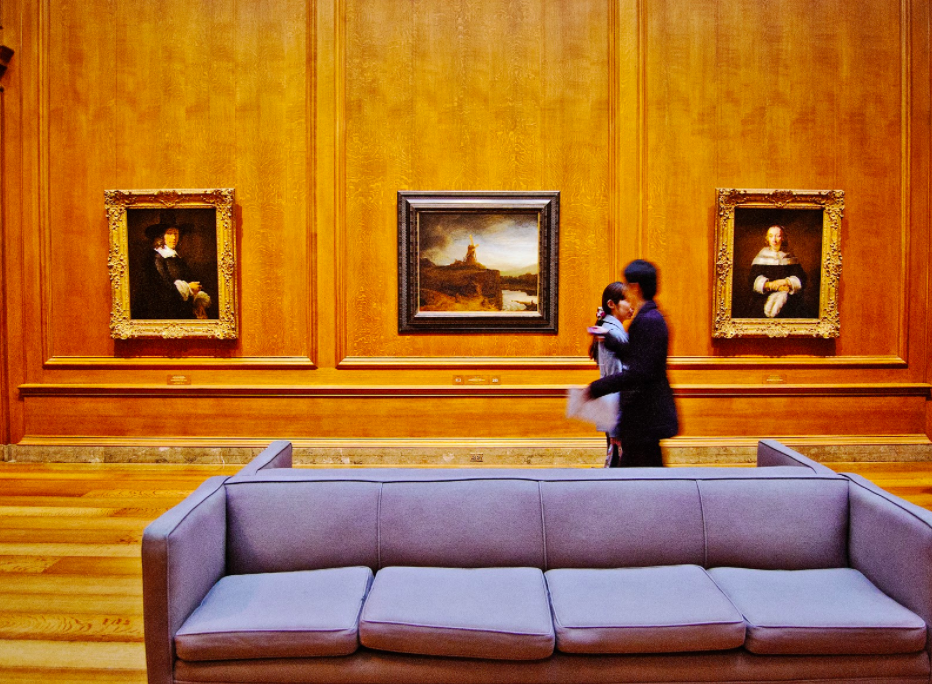aNewDomain  — Rembrandt’s “The Mill” is a prize exhibit that the National Gallery of Art in Washington. “Of all the paintings by Rembrandt in the National Gallery of Art,” the gallery’s website gushes, “none has provoked stronger feelings over the years than has The Mill … it is one of the greatest creations of the master.”
— Rembrandt’s “The Mill” is a prize exhibit that the National Gallery of Art in Washington. “Of all the paintings by Rembrandt in the National Gallery of Art,” the gallery’s website gushes, “none has provoked stronger feelings over the years than has The Mill … it is one of the greatest creations of the master.”
Thousands of art lovers and museum hoppers view Dutch master’s oil-on-canvas every day, says the museum. But according to Dutch mathematical artist Rinus Roelofs, the painting is, most likely, a fake.
The main problem with the painting, he says, is about angles and how the sails and blades on the mill are positioned. They are positioned in a way that would indicate the mill moves in a clockwise direction.
Only problem is, all mills in Netherland at the time and most mills now move counter-clockwise.
Rembrandt, who was born the son of a miller in 1606, would most assuredly have known better, Roelofs says.
Before we get into the rationale here, check out the painting. Here’s “The Mill.”

An oversight? Really?
It’s not as if Rembrandt would not have known better, he points out. Rembrandt van Rijn was born the son of a Dutch miller. He knew very well which way mills turn. And he would also know that you can’t just change a mill’s direction. If it turns in the wrong way, the millstones won’t engage or grind grain.
In an email, a representative from the National Gallery said only that the gallery “stands by the authenticity of the work.”
That’s fine, but I was intrigued by Roelof’s claim. So I dove in for a closer look.
A matter of symmetry
A miller’s son, like Rembrandt, would be unlikely to ever make such an error, says Roelofs.
Prevailing wisdom has always held that “The Mill” is modeled after the “Rembrandt Windmill” in the Dutch town of Kilder. That mill, by the way, has blades that certainly turn in the correct direction. There it is, below.

Here’s an etching by Rembrandt of that mill. Called “The Little Stink Mill” (1641), you can see the windmill blades are now reversed. That’s normal, though. The etching is a mirrored left-right image.

Could it be that one of Rembrandt’s many apprentices and assistants created the work in Rembrandt’s style but directly from the etching?
Then again, according to the Dutch scholar Christian Tiampel, within a generation of Rembrant’s death in 1669, the “Paris art market … “alued the Dutch realists and Rembrandt so highly that it was worthwhile to produce fakes purporting to be their works.” In England and Germany, too, he said, Rembrandt’s paintings, prints and drawings were eagerly collected, copied, imitated and sold.
Not surprisingly, it isn’t the first time observers have called Rembrandt paintings into question.
As for Roelofs, he is no stranger to artistic controversy around mills and great painters.
Not so long ago, he noted that the two windmills M.C. Escher’s “Day and Night” (1938) were mirrored and juxtaposed in a mathematically symmetrical way. As you can see from the work, the mill by night has sales that move its blades in the correct direction, the mill by day does not.
And in 2011, he was the first to note a geometric error in the work of Leonardo da Vinci.
What else could it be?
If “The Mill” at the National Gallery of Art really is a fake, it’s not surprising that it took so long for someone to spot the telling abberation.
The counterclockwise motion of most mills is something that’s easy to overlook, especially if you don’t know much about mills or milling.
Is there a clockwise-turning mill in existence anywhere that might have given Rembrandt the inspiration?
Unlikely. Clockwise mills are rare, even now. There’s a mill in Blumenau, Brazil that uses a motor to turn the blades clockwise, yet has the sales in the correct position. Also, there are a few clockwise mills in England and France.
The famous Moulin Rouge mill in Paris turns clockwise. But it’s motorized I dug into images of the original mill at Montmartre Hill, but the sales in early drawings are symmetrical, making it hard to tell if they might have turned in the wrong direction.
That’s not the case, as you now know, in ‘The Mill’ as attributed to Rembrandt: Those sales are obviously and clearly asymmetrical. And they are the centerpiece of the painting, a painting supposedy created by a miller’s son.
Anyway you look at it though, it seems exceedingly unlikely that a miller’s son like Rembrandt would ever have painted a wrong-way mill. His doing so would be just as implausible as a watchmaker’s son painting a clock with the numbers reversed.
The Counterclockwise Standard
It should be said that here are many theories for how windmill builders settled on the counterclockwise standard. Some say it reflects the right-handedness of the sails makers.
Others, like Raboud University professor Alan Edward Rowen, say it has to do with the direction of the wood fibers.
Because some trees naturally grow and slant toward the direction of the sun, the horizontal tree trunk that becomes the axis of the wind mill works best with blades moving in a counterclockwise directions.
If you can begin to accept the National Gallery’s “The Mill” is a forgery, the next question is: How did the painting get there?
Well, according to art historians, nineteenth century millionaire Peter Arrell Brown Widener (1834 -1915) donated “The Mill” and other paintings in his European collection to the National Gallery of Art back in 1911,
And if anyone noticed the strange positioning of the sails and blades in the painting at the time, no one spoke up on the record.
For aNewDomain, I’m Dirk Huylebrouck.
Cover image: PatsEastCoastTravels.com, All Rights Reserved. Inset: ‘The Mill,’ by Rembrandt Harmenszoon van Rijn (1645-1648). Public Domain.
Ed: aNewDomain editor Gina Smith and staffer Skimbo Jones contributed to this article.













